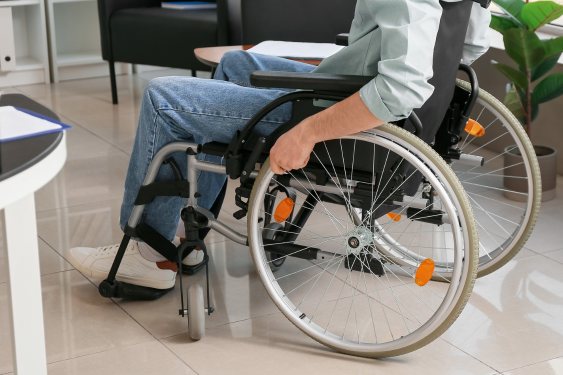For over 20 years, Patient Care Medical has been one of the largest suppliers of daily use urinary catheters in the United States and Puerto Rico. Check out our catheter catalog and request your free sample today!
About Spinal Cord Injuries
The spinal cord is located within the spinal column and has two basic functions. It can act as a nerve center and can work without the brain. The spinal cord carries sensory impulses to the brain and motor impulses from the brain. The fibers of the sensory root carry stimulations to the spinal cord (position sense, touch, pain, and temperature) from joints, tendons, and body surfaces. The motor roots carry signals from the spinal cord. The spinal cord also controls stretch reflexes, bladder, and bowel control. Thirty-one pairs of nerves exit from the spinal cord and innervate the entirety of the body and the limbs. Spinal nerves communicate to where they emerge and pass through the spinal vertebrae. There are eight cervical (neck), twelve thoracic (chest), five lumbar (lower back), five sacral (sacrum bone), and one coccygeal (tailbone) nerve(s). The spinal cord also acts as a nerve center between the brain and the rest of the body. It is a crucial part of the body, which means an injury to the spinal cord can be catastrophic to a person’s life and health.
The National Spinal Cord Injury Statistical Center (2014) estimated that the annual incidence of spinal cord injury, not including those who die at the scene of the injury, is approximately 40 cases per million population in the U.S. Injuries to the spinal cord more often than not begin with an unexpected, devastating strike to the spine that fractures or dislocates the vertebrae. The damage occurs in the same moment of injury and impact, when bone fragments, disc material, or ligaments that have been displaced bruise or tear into the tissue of the spinal cord. Depending on what has been injured, people with spinal cord injuries can also have their bowel and bladder control, as well as stretch reflexes, impacted by the trauma of the injury. Every injury to the spinal cord depends on the situation. Some individuals will be able to have a nearly full recovery of the injured areas and body. Other injuries will, unfortunately, result in complete paralysis. These factors all depend on how severe the injury is, where the injury occurred, and what caused it.
Causes of injuries to the spinal cord can vary. Common causes, however, are usually vehicle crashes, falls, and acts of violence (i.e. gunshot wounds). The National Spinal Cord Injury Statistical Center (2014) outlined that motor vehicle accidents account for 38 percent of reported spinal cord injury cases, which accounts for the majority of injuries. The second most common cause of injuries is falls at 30 percent, followed by acts of violence at 14 percent—primarily gunshot wounds. Other causes can be injuries from sports, diving, and industrial accidents.
Ranges in Injuries
Loss of neurologic function and paralysis typically occurs below the level of the injury. Therefore, the higher the spinal injury is on the spinal column, the greater loss of function is in the body. Below is a list of nerves, where they are located, and what part of the body is impacted when those areas are injured.
Cervical spinal nerves (C1 to C8) can be found on the spinal cord in the neck area and control impulses to the back of the head, the neck and shoulders, the arms and hands, and the diaphragm.
The thoracic spinal nerves (T1 to T12) emerge from the spinal cord in the upper mid-back area and have control over signals to the chest muscles, certain back muscles, many organ systems, and even some parts of the abdomen.
Lumbar spinal nerves (L1 to L5) emerge from the spinal cord in the low back region of the body and control stimulations to the lower parts of the abdomen and the back, some parts of the leg, the buttocks, and some parts of the external genital organs.
The sacral spinal nerves (S1 to S5) are located on the spinal cord in the low back and have control over any signals to the thighs and lower parts of the legs, the feet, most of the external genital organs, and the area around the anus.
Injuries to the spinal cord can be categorized as either tetraplegia or paraplegia in most cases. Tetraplegia (also known as quadriplegic) normally results from to an injury between the C1 and T1. This type of injury is typically associated with a loss of feeling or movement in the upper body such as the head, neck, shoulder, arms, hands and/or fingers. Paraplegia may result from an injury between levels T2 and S5. This type of injury can affect the lower part of the body the most, which includes the stomach, hips, legs, and feet/toes.
Incomplete tetraplegia and paraplegia is when the spinal cord’s ability to transport messages to or from the brain is not completely lost. Those with incomplete injuries to the spinal cord can still retain some sensory function if treated immediately, and they may still have motor activity below the injury site that they can control. On the other hand, complete tetraplegia and paraplegia entirely stops nerve communications between the brain and spinal cord to parts of the body below the site of injury. In these cases, there is a total absence of sensory and motor function in the sacral sections S4-5.
Neurogenic Bladder
The National Spinal Cord Injury Statistical Center proclaim 40 new cases of spinal cord injury per million of the population per year. More than 80 percent of those same individuals display at least some level of dysfunction in the bladder. Neurogenic bladder is the overall name for most bladder issues after an injury or illness. Neurogenic bladder is a complication where a person lacks bladder control due to a condition with the brain, spinal cord, or nerves.
Various muscles and nerves must work in combination with each other for the bladder to hold the urine, until it is ready to be emptied. Nerve messages also go back and forth between the brain and the muscles that control the bladder. If these nerves are harmed by injury, the muscles may not be able to constrict or relax at the correct time. Most spinal cord injuries affect the functions of the bladder because the nerves that control the involved organs originate in the segments near the lower end of the spinal cord. Although the kidneys continue to produce urine after injury, bladder control can be lost entirely. The chance of bladder and urinary tract infections (UTIs) increases at this point.
Disorders of the central nervous system commonly cause neurogenic bladder as well. These disorders can include birth defects of the spinal cord, spinal cord injury, multiple sclerosis, cerebral palsy, Parkinson’s disease, spinal cord or brain tumors, and Alzheimer’s disease. Damage or disorders of the nerves can also cause neurogenic bladder. This includes nerve damage (neuropathy), nerve damage because of long-term and heavy alcohol use, nerve damage due to long-term diabetes, and nerve damage from a herniated disk or spinal canal stenosis. Symptoms of neurogenic bladder depend on what the cause is of the neurogenic bladder.
Clean Intermittent Catheterization for Spinal Cord Injuries
Spinal cord injuries will often require individuals to perform intermittent catheterization, or take other medical steps to help manage their bladders. This could include behavioral techniques, physiotherapy such as massage therapy, transurethral and suprapubic catheters, as well as condom catheters and penile clamps. Intermittent catheterization is when a catheter is meant to be inserted and removed throughout the day in order to drain the bladder. This is an excellent choice for anyone with a condition or injury that does not allow them to empty their bladder properly or if urinary incontinence is being experienced.
Spinal cord injuries often require catheterization because the trauma to the spine may cause damage to the nerves that control the functions of the bladder. As seen above, there are numerous options for catheterization. Depending on your situation and condition/ injuries, as well as what other treatments your body responds to, catheterization may be best for your health and comfort. Choosing which catheter is best suitable for spinal cord injuries relies on where the injury is located and how complete or incomplete the injury is. Consulting your doctor and following the care and health regimen they order for you should always be a top priority.


